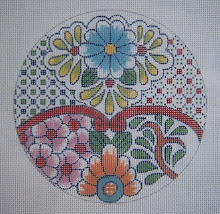 Returning to one of my favorite sources for needlepoint design - the Tiles of Mexico, including the beautiful Spanish Talavera, which are manufactured in Puebla. (Uriarte)
Returning to one of my favorite sources for needlepoint design - the Tiles of Mexico, including the beautiful Spanish Talavera, which are manufactured in Puebla. (Uriarte) Going through my rolls of painted canvases hidden away in boxes and on closet shelves (painting models for a number of years), I found this one that I had actually intended to stitch. I usually do just one square, as they are pretty enough alone - quick to do, and make great little pillow insets or purse patches. (at 5" square) This one I could see as a long, rectangular inset, and rather interesting.
I have loved Mexican pottery since I was a child - but oddly, when I was living in Mexico City long ago, I was apparently interested in other things, and didn't even realize that gorgeous Spanish Uriarte Talavera was in Puebla close by - just over the mountains. I went there often, and never even saw the ceramics.
 These tiles I'm showing were in a book on old tiles from San Miguel de Allende (another of my haunts, but I was doing papier mache' back then, and the Jeanne Valentine factory was there)
These tiles I'm showing were in a book on old tiles from San Miguel de Allende (another of my haunts, but I was doing papier mache' back then, and the Jeanne Valentine factory was there) Anyway, these lovely works of art can stand on their own as a single piece for needlepoint, or in arrangements of multiples. Four is great for a pillow, and the look; as with Patchwork patterns, is different according to how they are put together.

I had to make copies of color scans of the original canvases, as those are long gone, and then cut them up - soooo they don't quite fit, as you can see. You get the idea.
 The second design is one of my very favorites, and I have stitched the single square for myself - but have no idea where it is. May have to do this one again for myself, but as the full four-square pillow that is 10 1/2" square. I have made the tiles all 5" square, but like the effect of leaving two threads between them to give the effect of grout.
The second design is one of my very favorites, and I have stitched the single square for myself - but have no idea where it is. May have to do this one again for myself, but as the full four-square pillow that is 10 1/2" square. I have made the tiles all 5" square, but like the effect of leaving two threads between them to give the effect of grout. I prefer the arrangment of the dark elements in the center, but changing them is certainly an interesting effect.

The last photo (the paper squares don't fit) is really pretty as just a single tile - but also interesting in this format. I tried putting the bright flowers in the center, but somehow it didn't look quite right.
 I'm preparing a "tutorial" right now (Drawing on Canvas 202) that I hope to have finished by this evening on drawing a tile on canvas - I've chosen to use the first illustration, as it's simple to do, and will lay the foundation for your doing your own. Also remember that the same technique applies to putting together patchwork squares to form different effects!
I'm preparing a "tutorial" right now (Drawing on Canvas 202) that I hope to have finished by this evening on drawing a tile on canvas - I've chosen to use the first illustration, as it's simple to do, and will lay the foundation for your doing your own. Also remember that the same technique applies to putting together patchwork squares to form different effects! If it isn't up tonight, do see it tomorrow (Friday) on Freebies, etc.
ADDENDUM: Due to an internet problem, I only finished putting the "how to draw your own" instructions for the Mexican tile (illustrated at the top) on Freebies, etc. It's ready now!!

7 comments:
These are the kinds of pieces I love to see! Like me, you didn't design them while you were living in the country where they originate. More pottery please!! They just beautiful!
This will be very interesting to follow what you do with this!
Wow, those are *all* lovely. One could play for hours with those tiles...!
Hi Judy,
Love the tiles and how you've adapted them to needlepoint. :-)
Cynthia
Windy Meadow
I really enjoyed your post but have a question. I am trying to learn more about Jeanne Valentine and her paper mache work. I know virtually nothing other than I just purchased a piece believed to be by her.
Anything that you can tell me about her would be immensely helpful.
Thanks!
Hello! I am also inquiring about Jeanne Valentine. I have one of her 60' lifesize papier mache cats and would like more backgtound on her work, could you help?
OOPS! I see I missed another question about J. Valentine - I had bought things of hers way before I moved to Mexico City and saw the things at her place in San Miguel de Allende. I took a class in doing this, as well as learning some other papier mache' techniques - like "porcelainizing" faces (with Elmer's glue). We just used, as she did, torn (not cut) newspaper squares and applied them with either wallpaper paste or white glue. Any raised string design was done with white cotton rope first soaked in white glue and water - then acrylic paint, etc. You can e-mail me for more by looking at my profile - the address is there. I need to do this for a blog post, I think. I have the materials at hand.
Post a Comment